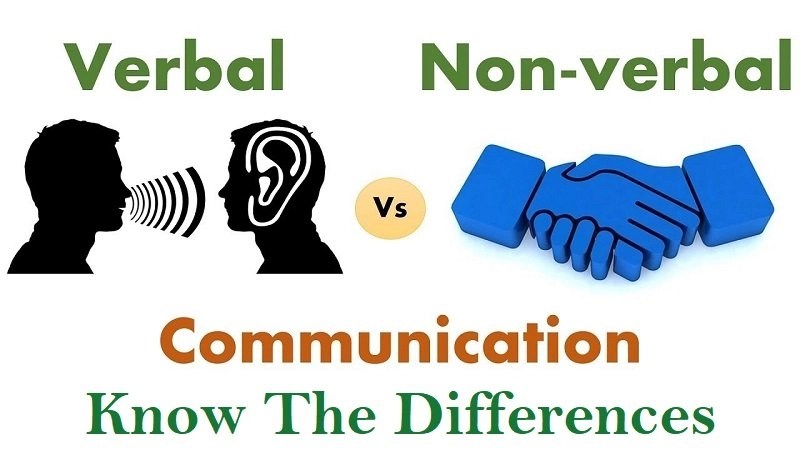
What is Verbal and Non-verbal Communication?
Verbal Communication:
This is the use of words, phrases, sounds, and other forms of human expression. It’s a deliberate attempt to convey thoughts, feelings, opinions, and desires between two or more people.
Speech: Our verbal communication is dependent primarily on our voice, which can be affected by many factors. Some of them are stress, fatigue, illness, or even a cold. Moreover, some people have an accent or do not pronounce words correctly due to their geographic location or educational background. Especially in business meetings where different cultures and nationalities come together, it becomes essential to consider all these aspects before communicating with others verbally because misunderstandings may occur otherwise.
Nonverbal Communication:
It refers to all body language signals, including facial expressions, hand gestures, eye contact, and posture, which can communicate meaning beside or in place of spoken words. Different regions around the world use different rules for non-verbal communication. Also, different people establish their signs which they use to communicate with others. For example, someone might give you the thumbs-up sign to mean everything is excellent, while another person could use the same gesture to imply they are not happy.
Examples of Verbal and Non-verbal Communication
When we talk with others, we will often use Verbal communication and Non Verbal communication. Verbal communication is when we try to get our message across using words and specific phrases, such as: “Would you like something to drink?” We tend not to use these phrases when we are talking with someone because it seems too formal. However, there is another way of communicating with other people, known as non-verbal communication. It means that we communicate without saying any actual words. Examples of this would be: raising your eyebrows or frowning because the person would understand what you mean by doing these things.
Verbal Example: Saying something like, “If you could move your car, I would appreciate it.”
Non-Verbal Example: Using facial expressions or hand gestures to get the point across without speaking.
Verbal Example: “I don’t think that your boss will allow us to do that because she is quite stubborn as well.”
Non Verbal Examples:
- Having a positive facial expression when we are happy about something we have been told
Smiling and nodding our head to show that we agree with what somebody just said
Verbal Example: “I’m not sure if we should invest in this product because I don’t think it’s going to make much of a profit.”
Non-Verbal Example: Making eye contact with the speaker to show them you’re interested
Verbal Example: “I don’t know what they are talking about; it’s all too confusing for me.”
Non-Verbal Example: Shrugging our shoulders to show that we have no idea
As you can see, Verbal communication is relatively straightforward. Still, non-verbal communication is more of a guessing game because it is hard to determine if someone else has understood your meaning without using words. Verbal communication is also more formal than non-verbal communication. Verbal and Non-Verbal Communication is important because if we didn’t communicate with people, it would be tough to get through life. After all, we would have nobody to talk to about our problems. The two types of communication are two different means of communication that will help you in your day-to-day life.
What are the Peculiarities of Verbal and Non-verbal Communication?
Verbal and non-verbal communication are the two main types of communication that we do daily. Verbal communication is anything we say, for example: “I’m going to the shops!” We all understand what verbal means, so no explanation there! Non-verbal communication means communicating with our body/facial expressions and gestures. It also includes how we dress and any objects we communicate with, such as pens or key rings. For example, I may give my friend a hug when she gets good grades because I am happy.
1) Verbal communication is anything that requires spoken words, whether said out loud or written down. It can be performed in many different forms, including phone calls, video calls, emails, and letters. Verbal communication is often used to express our feelings or emotions towards something or someone, while non-verbal communication often relates to what we are physically doing at the time. Verbal communication is also vital for people who cannot use non-verbal communication because their facial expressions don’t match their words. It can be used in many different ways, including making new friends, asking for help, and even breaking up with someone! Verbal communication is also essential when writing reports on certain topics. It requires students to put together lots of information they’ve found through research into an essay format.
2) Non-verbal communication tells us more about how you feel than what you say, which is why people must learn how to read body language gestures. We can use Verbal communication in non-verbal ways, such as the words “I love you,” which are said aloud and accompanied by a hug or even an enthusiastic high five. Non-verbal communication includes many different forms of expression, including tone of voice, facial expressions, and physical contact. This type of communication is often used when we cannot speak because our environment is too loud, there are other people around us, or the noise level isn’t appropriate for talking loudly. Verbal communication becomes necessary when non-verbal methods do not work appropriately.
11 Differences between Verbal and Nonverbal Communication
Although both types of communication create meaningful messages that allow people to share thoughts, ideas, and opinions effectively, there are several differences between verbal and nonverbal communication. For example:
1) The amount of information that can be transmitted through verbal and nonverbal channels is different. Spoken language can be pervasive, while body language offers fewer options to express specific ideas or thoughts.
2) Nonverbal communication is more ambiguous than verbal communication since it’s subject to interpretation by the receiver, which may lead to misunderstandings. In other words, many factors affect non-verbal signals not present in verbal messages. For instance, there are no regional accents in sign language. Moreover, the same gesture has a different meaning from culture to culture and even within a single country.
3) Verbal communication is linear, while nonverbal signals exist in various forms. For example, facial expressions can illustrate emotions through more than one channel simultaneously.
4) People communicate more efficiently, accurately, and better understand when using verbal language than nonverbal signals or body language. This is because, in verbal communication, people have the opportunity to tone down, clarify or repeat information if there are any misunderstandings. Moreover, in writing, one selects words carefully not to change the meaning of their message by mistake.
5) Speech has a more significant effect on us emotionally since it’s transmitted chiefly through our right brains, responsible for feelings. On the other hand, most nonverbal signals are linked to a reason through our left brains.
6) Verbal and non-verbal communication differ in the way we use them. Nonverbal communication is universal, whereas verbal communication varies from place to place and person to person. This is because of different factors such as culture, geographical location, education level, and economic status. Verbal communication is very open. This means that the message can be easily interpreted by others and become distorted in transmission. Sometimes, body language can contradict words. On the other hand, we cannot always trust non-verbal communication. The information may not always be reliable because it is easy to manipulate or misinterpret.
7) Verbal communication is more noticeable than nonverbal communication. For example, if someone yells out in anger at you, it will surely grab your attention much faster than if they sat silently facing away from you while staring at the floor.
8) People can communicate using verbal means while doing other things simultaneously. However, people cannot communicate using non-verbal means while carrying out another task. For instance, when talking on the phone or watching TV, one can still use gestures or facial expressions to convey feelings and emotions.
9) Nonverbal communication flows freely, whereas other types of communication are almost always planned since one has to arrange their thoughts before speaking or writing them down. Therefore, nonverbal signals are less likely to be misinterpreted than when using verbal language.
10) When it comes to business meetings, negotiations or discussions, one can use gestures or expressions to convey their thoughts. However, remember that most people disapprove of talking with your mouth full while eating in front of others. It is because nonverbal communication does not replace the need for good manners and politeness.
11) Lastly, nonverbal communication is more efficient in creating an atmosphere of intimacy since physical contact is often involved. For instance, hugging someone shows you care about your friend much more effectively than using words alone.
In summary of the above, we communicate more than we care to know, but some types of communication may interrupt or conflict with others. We often use Verbal and Non-verbal communication at the same time to express different ideas. We may use Verbal and non-verbal communication to create a successful message as Verbal communication can be seen as too direct. In contrast, non-verbal can make people feel uncertain or annoyed if not given in the correct situation. Verbal and non-verbal communication has many benefits, such as helping us learn more about what someone else is feeling and showing us how we should react when speaking with other people. Both types of communication is an important skill that everyone needs to learn!



